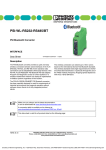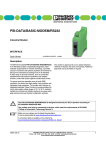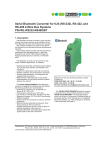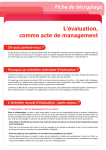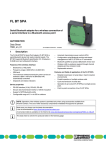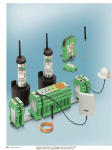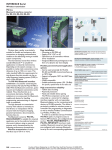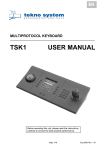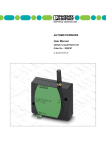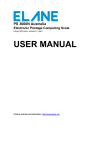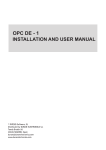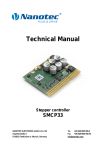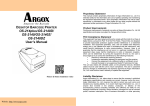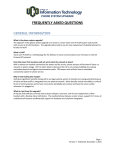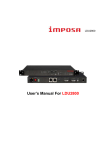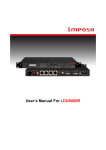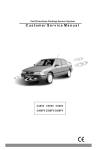Download Data Sheet DB EN PSI-WL-RS232
Transcript
PSI-WL-RS232-RS485/BT PSI Bluetooth Converter INTERFACE Data Sheet 102403_03_en © PHOENIX CONTACT - 06/2007 Description The PSI Bluetooth converter provides a quick and easy wireless connection between serial interfaces of the V.24 (RS-232), RS-422, and RS-485 2-wire standard. Data connections can be established to third-party devices or the PSI-WL-PLUG-RS232/BT PSI Bluetooth RS-232 adapter. Program and diagnostic access to control systems or a wireless master/slave network can easily be implemented in fieldbus systems regardless of the location. The wireless connection can extend up to 150 m and is based on the international license-free Bluetooth standard. This wireless standard meets high requirements for interference-free data transmission, in particular through the use of the FHSS method (Frequency Hopping Spread Spectrum) with the 2.4 GHz ISM band. The PSI-WL-RS232-RS485/BT PSI Bluetooth converter has been specially designed to meet the requirements of industrial environments and supports operation without software drivers thanks to its fully integrated protocol stacks. . If you have any technical problems, which you cannot resolve with the aid of this documentation, please contact us during the usual office hours at: PSI hotline: +49 - 52 35 - 31 98 90 Fax: +49 - 52 35 - 33 09 99 E-mail: [email protected] Make sure you always use the latest documentation. It can be downloaded at www.download.phoenixcontact.com. A conversion table is available on the Internet at www.download.phoenixcontact.com/general/7000_en_00.pdf. PSI-WL-RS232-RS485/BT Ordering Data PSI Bluetooth Converter Description Type Order No. Pcs./Pck. PSI Bluetooth converter PSI-WL-RS232-RS485/BT 2708517 1 Type Order No. Pcs./Pkt. RAD-ISM-2400-ANT-OMNI-2-1 2867461 1 RAD-ISM-2400-ANT-PAN-8-0 2867610 1 RAD-PIG-EF316-MCX-SMA 2867678 1 MINI-SYS-PS-100-240AC/24DC/1.5 2866983 1 for converting V.24 (RS-232)/RS-422/RS-485 2-wire to Bluetooth, range with omni-directional antenna up to 150 m, DIN rail mounting, 24 V supply; Scope of supply: DIN-rail mountable Bluetooth device, CD with configuration software, and user manual Accessories Description Lambda/4 antenna with omni-directional characteristics, mounting bracket Antenna cable with angled antenna connector Gain Degree of protection Dimensions 1.50 m, MCX 0 dBi IP65 Ø 8.2 x 82.5 mm Panel antenna with directional characteristics, mounting clamp, and antenna connection Gain Degree of protection Dimensions (H x W x D) Ø 40 mm ... 60 mm SMA 8 dBi IP55 101 x 80 x 20 mm Coaxial antenna cable for panel antenna Connections Attenuation Impedance System power supply Primary-switched Input voltage range Nominal output voltage Nominal output current 1m MCX/SMA 2 dB 50 Ω 45 Hz ... 65 Hz 85 V AC to 264 V AC 24 V DC ±1% 1.5 A DIN rail bus connector ME 22.5 TBUS 1.5/ 5-ST-3.81 GN 2707437 1 V.24 (RS-232) cable, 2 m, to connect the converter to a 9-pos. device interface 9-pos. D-SUB/ 9-pos. D-SUB (Female/female) PSM-KA9SUB9/BB/2METER 2799474 1 V.24 (RS-232) cable, 2 m, to connect the converter to a 25-pos. device interface 9-pos. D-SUB/ 25-pos. D-SUB (Female/female) PSM-KA9SUB25/BB/2METER 2761059 1 V.24 (RS-232)/USB converter, 1.8 m, to connect the converter to a USB interface 9-pos. or 25-pos. D-SUB/ USB Type A (Male/male) CM-KBL-RS232/USB 2881078 1 Technical Data Power Supply Supply voltage 1 10 V DC ... 30 V DC, 19 V AC ... 29 V AC Via plug-in COMBICON screw terminal block, protection against polarity reversal via bridge rectifier Supply voltage 2 (alternative or redundant) 24 V DC ±20% Via backplane bus contact and appropriate system power supply, protection against polarity reversal via series diode Frequency DC or 50 Hz ... 60 Hz Nominal current consumption 40 mA at 24 V DC, approximately 70 mA RMS at 24 V DC, approximately LED indicators VCC (green LED): – Steady light during operation in RUN mode – Flashing during operation in CONF mode 102403_03_en PHOENIX CONTACT 2 PSI-WL-RS232-RS485/BT Configuration System requirements Windows 98 SE, 2000, NT4, XP Configuration interface V.24 (RS-232) or Bluetooth The system is configured in CONF mode via the V.24 (RS-232) interface and the configuration software supplied. Either the directly connected device is configured or the remote device is configured via Bluetooth. Serial Interfaces V.24 (RS-232) Interface Physics EIA/TIA RS-232 Connection 9-pos. D-SUB pin strip Device type DCE (Data Communication Equipment), with 1:1 cable to DTE (Data Terminal Equipment) Signal assignment TxD = 3, RxD = 2, RTS = 7, CTS = 8, DTR = 4, DSR = 6, GND = 5 Data format Serial asynchronous UART/NRZ Encoding 7/8 data, 1/2 stop, 1 parity, 10/11-bit character length, can be adjusted via software Serial transmission speed 0.3, 1.2, 2.4, 4.8, 7.2, 9.6, 19.2, 31.25, 38.4, 57.6, 75, 93.75, 115.2, 136, 187.5 (kbps) Data flow control Hardware handshake: Termination device directly with the PSI Bluetooth converter via RTS/CTS with 187.5 kbps, maximum Software handshake: Xon/Xoff is negotiated directly between the termination devices. Setting on the PSI Bluetooth converter: "none" up to 38.4 kbps, maximum Message-oriented protocols: For example, Modbus, PROFIBUS, etc.: Setting on the PSI Bluetooth converter: "none" up to 93.75 kbps, maximum Default upon delivery 9.6 kbps, 8 data, no parity, 1 stop bit, hardware handshake LED indicator/serial data indicator TD (yellow LED), dynamic, serial port is transmitting data RD (green LED), dynamic, serial port is receiving data LED indicator/serial system diagnostics SER ERR (red LED), parity error, handshake error, buffer data overrun RS-422/RS-485 2-Wire Interface Physics EIA/TIA RS-422 and RS-485 2-wire, default upon delivery: V.24 (RS-232), can be switched via software Connection Plug-in COMBICON screw terminal block Termination resistor/termination 390/150/390 Ω can be enabled, default upon delivery: OFF Signal assignment for RS-422 Transmit positive = TB, Transmit negative = TA Receive positive = DB, Receive negative = DA Signal ground = GND, Shield = FE Signal assignment for RS-485 2-wire Transmit/Receive positive = DB Transmit/Receive negative = DA Signal ground = GND, Shield = FE Bluetooth Interface Physics Bluetooth 2.0 specification Frequency 2.402 GHz ... 2.480 GHz (ISM band) Channel distance 1 MHz Bandwidth 79 MHz Number of channels 79 Transmission method Adaptive Frequency hopping 1.6 kHz (AFH) R&TTE device class Class 2 Bluetooth device class Class 1 = 20 dBm (100 mW), maximum Transmission power Default upon delivery: 20 dBm, can be adjusted via software -28 dBm ... +20 dBm Range guide values (depending on the application environment) 20 dBm = 80 m to 150 m 10 dBm = 40 m to 70 m 0 dBm = 10 m to 30 m Receiver sensitivity -80 dBm at 0 dBi antenna gain Antenna External antenna, not included in the scope of supply (see list of accessories) Antenna connection MCX 102403_03_en PHOENIX CONTACT 3 PSI-WL-RS232-RS485/BT Bluetooth Interface (Continued) Bluetooth profiles – – – – – GAP / Generic Access Profile (access regulation) SDAP / Service Discovery Application (device detection) SPP / Serial Port Profile (serial transmission) DUN / Dial-Up Networking Profile (internet dialing connection) LAP / LAN Access Point Profile (network connection) Number of Bluetooth masters/Bluetooth slaves 1x master/7x slaves LED indicator/Bluetooth data indicator BT SIGNAL (1x yellow LED flashing) Bluetooth is transmitting/receiving data LED indicator/Bluetooth transmission quality – BT SIGNAL (1x yellow LED, 2x green LEDs) Very good reception – BT SIGNAL (1x yellow LED, 1x green LED) Good reception – BT SIGNAL (1x yellow LED) Poor reception, close to the system reserve General Data CE conformance According to R&TTE directive 1999/5/EC RoHs conformance Yes Approvals / radio approvals Europe ETSI EN 300328, ETSI EN 300826 USA UL 508 / UL 1604, FCC/CFR47 Part 15 Canada RSS-210 Ambient operating temperature range -20°C ... +60°C Housing ME 22,5 with 5-pos. ME-T bus contact and ground contact Material ABS-V0, green Dimensions (H x W x D) 99 x 22.5 x 114.5 mm Weight 120 g, approximately Functional earth ground Housing contact with DIN rail Vibration resistance Criterion A According to DIN EN 60068-2-6 5g, 2.5 h in each x, y, and z direction Shock test (operation) Criterion C According to DIN EN 60068-2-27 15g, 11 ms, half-sine shock pulse Free fall According to DIN EN 60950-1 from a height of 1 m (without packaging) Degree of protection IP20 Air and creepage distances According to DIN EN 60664-1/VDE 0110-1, DIN EN 50178, DIN EN 60950-1 Separate ground levels 24 V (supply) // 5 V (logic) + serial ports // functional earth ground Test voltage 1.5 kV AC, 50 Hz, 1 min. between all ground levels according to DIN EN 50178 and DIN EN 61131-2 Chloroform test Free from substances that would hinder coating with paint or varnish according to central standard P-VW-3.10.757 650 of VW, Audi, and Seat Conformance With EMC Directive 89/336/EC Electrostatic discharge (ESD) EN 61000-4-2 Criterion B 8 kV air discharge 6 kV contact discharge Electromagnetic HF field EN 61000-4-3 Amplitude modulation 10 V Pulse modulation Fast transients (burst) Criterion A 10 V EN 61000-4-4 Criterion B Signal 2 kV/2 min. Power supply 2 kV/2 min. 102403_03_en PHOENIX CONTACT 4 PSI-WL-RS232-RS485/BT Conformance With EMC Directive 89/336/EC (Continued) Surge current load (surge) EN 61000-4-5 Criterion B Signal 1 kV/42 Ω Power supply 0.5 kV symmetrical/2 Ω 0.5 kV asymmetrical/12 Ω Immunity to interference EN 61000-4-6 Criterion A 10 V Conducted emission EN 55011 Class A Radiated emission ETSI EN 300328: V1.4.1, V1.2.1 Conducted interference Noise emission Conformance With R&TTE Directive 1999/5/EEC EMI Immunity to interference (electromagnetic compatibility of wireless systems) EN 61000-6-2 Generic standard for the industrial sector Safety EN 60950-1 Protection of personnel with regard to electrical safety Health Limitation of exposure of the population to electromagnetic fields EC Gazette 1999/519/EC EC Council recommendation of July 12, 1999 Radio Effective use of the frequency spectrum and prevention of radio interference ETSI EN 300328: V1.4.1, V1.2.1 Block Diagram 2 4 V B a c k p la n e V C C 2 4 V V C C 5 V g r e e n + 5 V 0 V 2 4 V 0 V D -S U B -9 R S -2 3 2 D C E T x D 3 R x D 2 R T S 7 C T S 8 D T R 4 D S R 6 G N D 5 + 5 V 3 9 0 W R D g r e e n T D y e llo w P u s h R E S T e r m in a tio n 3 9 0 W 1 5 0 W S W R S -2 3 2 R S -4 2 2 R S -4 8 5 (A ) D (B ) H W M C X A N T - S w itc h C O N F B lu e to o th µ C R U N T (A ) T (B ) G N D B T S ig n a l C O M B IC O N R S -4 2 2 / R S 4 8 5 W 2 D - S w itc h b u tto n ( S h ie ld ) g r e e n g r e e n y e llo w r e d S E R Figure 1 102403_03_en E R R 7 0 6 5 B 0 1 3 Block diagram PHOENIX CONTACT 5 PSI-WL-RS232-RS485/BT Housing Dimensions 2 2 .5 1 1 4 .5 P S I-W L -R S 2 3 2 R S 4 8 5 /B T O rd .-N o . 2 7 0 8 5 1 7 9 9 V C C T D A N T R D R E S B T S IG N A L S E R E R R R S 2 3 2 6 1 4 5 1 0 0 1 7 0 6 5 B 0 1 6 Figure 2 Housing dimensions (in mm) International Approvals (As At 06/2007) The PSI-WL-RS232-RS485/BT has a maximum transmission power of 100 mW (20 dBm) and corresponds to R&TTE device class 2. At the time of going to print, the operation of this device had been approved/notified for the following countries: European Union (EU) Austria, Belgium, Czech Republic, Cyprus, Denmark, Estonia, Finland, France1, Germany, Great Britain, Hungary, Ireland, Italy2, Latvia, Lithuania, Luxembourg, Malta, The Netherlands, Poland, Portugal, Slovakia, Slovenia, Spain, Sweden. Europe (excluding EU) North America Iceland, Norway (excluding Spitzbergen), Switzerland Canada, USA 1 Outside buildings, a maximum transmission power of 10 mW (10 dBm) is permitted. 2 A license is required to use the adapter outside buildings. A maximum transmission power of 10 mW (10 dBm) is permitted. 102403_03_en PHOENIX CONTACT 6 PSI-WL-RS232-RS485/BT Operating Elements 1 2 1 3 1 4 1 5 1 1 1 6 1 0 1 7 P S I-W L -R S 2 3 2 R S 4 8 5 /B T O rd .-N o . 2 7 0 8 5 1 7 9 8 V C C T D A N T R D 7 6 1 8 R E S 5 B T S IG N A L 4 3 S E R 2 1 9 E R R R S 2 3 2 1 6 1 4 5 1 0 0 1 Figure 3 1 2 3 4 5 6 7 8 9 10 11 12 13 14 15 16 17 18 2 0 1 0 2 4 0 3 A 0 1 9 Operating elements V.24 (RS-232) data interface, 9-pos. D-SUB Red LED (SER ERR) Yellow LED (BT SIGNAL) Green LED (BT SIGNAL) Green LED (BT SIGNAL) RESET button: Resets settings Green LED (RD) Yellow LED (TD) Green LED (VCC) Shield connection GND (operating ground) 24 V supply (10 V DC to 30 V DC, 19 V AC to 29 V AC) 0 V supply T(A) transmit data – T(B) transmit data + D(A) data wire – D(B) data wire + Antenna connection (MCX female connector) The antenna is mounted outside the control cabinet. Observe the mounting instructions for the antenna used. 19 Terminate switch (activates and deactivates termination resistors for RS-485 and RS-422) 20 RUN/CONF switch 102403_03_en PHOENIX CONTACT 7 PSI-WL-RS232-RS485/BT Features The PSI-WL-RS232-RS485/BT serial PSI Bluetooth converter is designed for industrial use and features the following performance characteristics: – Mounting by snapping onto a DIN rail – Supply of 24 V DC or AC – Transmission speed of up to 187.5 kbps – Can be set to V.24 (RS-232), RS-422 or RS-485 – Supports all popular 10/11-bit UART data formats – 3964R-compatible – External antenna connection for optimum antenna positioning – Bluetooth access protected by password, fixed device pairing or device access list – Scalable transmission power (-28 dBm to +20 dBm) for specific localization of the radio cell – Integrated Bluetooth path diagnostics indicate the signal quality of the radio connection The PSI Bluetooth converter can be used for a wide range of different applications, for example: – Replacement of simple, serial point-to-point cabling for V.24 (RS-232), RS-422, and RS-485 2-wire interfaces – Creation of master/slave multi-drop connections – Wireless operation and monitoring for processes – Wireless parameterization, and diagnostic and programming connections – Replacement of slip ring joints or drag chains – Implementation of high-quality electrical isolation between the stations Application Examples The PSI-WL-RS232-RS485/BT PSI Bluetooth converter is accessed via a second identical device or via the PSI-WL-PLUG-RS232/BT PSI Bluetooth V.24 (RS-232) adapter, which is designed as a connector. Wireless access via third-party devices, which already have an integrated Bluetooth interface, e.g., PDA, notebook or cell phone, is also supported. Point-to-Point Connection Examples for Point-to-Point Connections Without Termination Device Addressing (V.24 (RS-232), RS-422, etc.) Programming Device and PLC Direct programming connection between a laptop and a programmable logic controller (PLC). 7065B005 PDA and PLC Data connection between a third-party device with integrated Bluetooth interface (PDA or cell phone) and an industrial controller. 7065B006 102403_03_en PHOENIX CONTACT 8 PSI-WL-RS232-RS485/BT PLC and Operator Interface Connection between a mobile operator interface and an industrial controller. 7065B007 Example for a Point-to-Point Connection With Termination Device Addressing (RS-485 2-Wire) RS-485 2-Wire Bus System Integration of a device into an existing bus system, e.g., Modbus or PROFIBUS. 7065B009 Multi-Drop Connection Networking of Automation Components One example is a PC-based control system with an RS-232 interface. Up to seven Bluetooth slaves can be connected to a Bluetooth master. PSI-WL-RS232RS485/BT Ord.No. 27 08 517 VCC TD RD ANT RES BT SIGNAL SER ERR RS 232 7065B008 © PHOENIX CONTACT 06/2007 102403_03_en PHOENIX CONTACT GmbH & Co. KG • 32823 Blomberg • Germany Phone: +49-(0) 5235-3-00 • Fax: +49-(0) 5235-3-4 12 00 www.phoenixcontact.com 9









